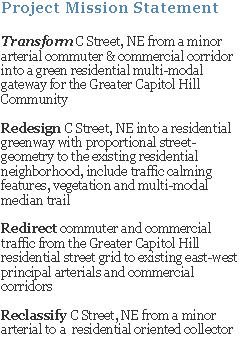
The above street cross-section is one type of bike lane configuration DDOT is considering as the DC creates a more city-wide bicycle-friendly infrastructure. This section would not necessarily be a direct application to C Street, NE. This type of configuration is more suited for commercial, high-density opposed to residential medium density. In short, asymmetrical to symmetrical layouts. Also, the example section is approximately 65ft wide (sidewalk curb to sidewalk curb) and C Street is approximately 90ft wide.
Refer to the post, "NYC Gets Its First-Ever Physically-Separated Bike Path" on StreetsBlog dated 09/20/07 for more information on this type of bike-lane configuration.
Below are several items Allan considers beneficial to the above street-scape cross-section:
1. You don’t have to cross traffic to enter a median bike path.
o This [raised center median path] would require having to retime the signals in the corridor to provide bike/ped only time to cross into the center median bike path.
o This [crossing traffic lanes to enter a raised center median path] could also raise serious safety issues.
o It [physically separated bike lane] would also be able to tie in easier to the Anacostia Trail by either continuing on the same side or only crossing C St NE once.
2. Safety would be increased since:
o you would not be in between two directions of traffic [raised center median path scenario]
o the street layout [physically separated bike lane] would be grade separated and protected by a line of parked cars. (sidewalk, planted strip, bike path, planted strip, parking lane, two lanes of traffic, planted median, two lanes of traffic, parking lane, bike path, sidewalk) This is just one potential layout of the right-of-way.
3. Being in between two directions of traffic would expose bikers/pedestrians to heavier amounts of noise and exhaust. [raised center median path scenario]
4. This is more in line with bike path planning and trends around the world and potentially in DC. [physically separated bike lane]
Please post your thoughts on either a "raised center median path", a " physically separated path" or some other potential design. Consider a design layout that would essentially connect and extend the recently constructed Anacostia River Trail (ART) at the northeast corner of C & 21st Street, NE.


3 comments:
I am not sure how DDOT would incorporate such elements into the existing C Street right-of-way (ROW). But, I still believe a raised-median, vegetative-buffered bike path, similar to the conceptual layout on the C Street blog, is better suited for a residential application, here is why:
1. Once on the median path, the user potentially has less vehicular lanes to cross to access the neighborhood and the Anacostia River Trail.
2. It provides greater area for vegetation, including a buffer between the Eliot-Hines JHS & C Street and median-path users & C Street.
3. It provides a more constricted visual perception to the motorist, potentially slowing overall vehicular speeds.
4. It provides a more residential "boulevard" look and feel to residents, pedestrians and motorist.
DDOT's feasibility study hopefully will consider different layouts to achieve the best balance of the above items. We'll have to wait and see.
Just my opinion.
Ken
I'm skeptical of a center-running bicycle path. Downtown Minneapolis (MN) has center-running bike lanes on Hennepin Ave, and the city has found that center-running lanes had the effect of increasing accidents...they're doing away with them over the next year and following through with a shared right lane on Hennepin and side-running bike lanes on 1st Ave N (an adjacent parallel street).
I'd be much more comfortable with side-running bike lanes (separated or not) along C Street than the proposed center-running configuration.
I am neutral at this stage re. what would be the best design for a redesigned C St with one less West-bound lane as long as get rid of the West-bound lane and get more green space. I really like the bulb-out idea.
I see pro and cons to the leading two proposals -- the center-running bike lane vs the physically separated bike lanes in both directions. I hope DDOT examines both proposals and perhaps consider a few additional ones, including perhaps a third one described below.
I do hope DDOT looks into allegations made by the DC bike community that the center-bike lane/island does not have a good safety record for bikers. Whatever solution is implemented it needs to balance esthetics with safety for pedestrians, bikers and cars.
Esthetically, I find Ken's center-bike lane to be very attractive though I'm not sure the street is wide enough to guarantee that the proposed area set aside for vegetation on each side of the bike lane will be wide enough to guarantee the trees or plans will survive.
Another option that would maximize sustainable green space along the road is basically to get rid of the median entirely or almost entirely (perhaps keep a 1-2 foot raised divider/median), get rid of one West-bond lane, have traditional bike lanes on each side of the street (i.e. as we have now), 1 parking lane on each side and dramatically widen the "tree/green" boxes between the street and the sidewalks on both sides. In sum, what we gain from reducing the size of the median and from eliminating one lane becomes wider "tree boxes" and/or side walks. By doing this, the city/neighbors could plant more trees and vegetation on each side of the street and these plantings would be more sustainable because they would have more room to grow. Just an idea to through in the mix.
Post a Comment